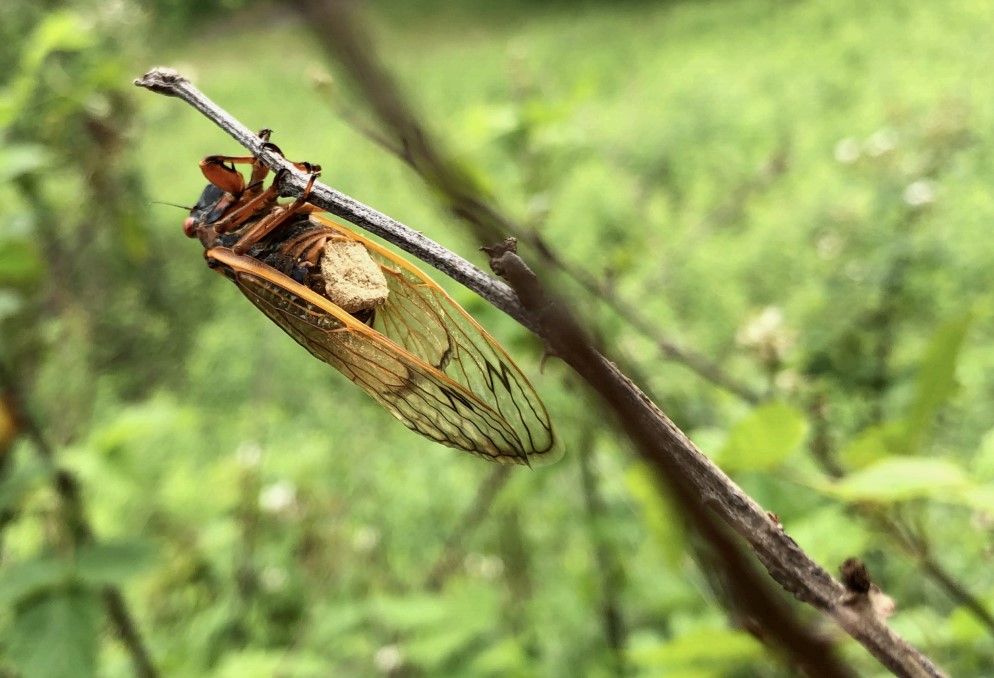Prime numbers protect Brood X cicadas from everything but zombie fungus
Periodical cicadas only emerge every 13 to 17 years, a trick that may keep predators from adapting to the insect feast. But one fungus isn't deterred.

After spending 17 years underground, trillions of cicadas will emerge this spring to creak out their ear-splitting mating songs and litter tree trunks with their eerie molted skin.
It's weird enough that Brood X, as this enormous influx of cicadas is known, somehow manages to emerge all at the same time after nearly two decades beneath the soil. What's even weirder is that the cicadas may use math to protect themselves from predators — well, most predators. No matter what these cicadas do, they're still susceptible to a fungus that turns them into zombies with disintegrating butts.
If this seems like a lot, well … it is. It turns out that the emergence of cicadas expected this May is a story encompassing evolution, math and some seriously gross parasites.
There are numerous species of cicada, all with life cycles that occur partly underground and partly aboveground. Some species emerge every year, others every few years. But then there are seven species of true weirdos: Periodical cicadas, all of which have either 13-year or 17-year emergence patterns. These periodical cicadas are a beloved species of entomologists and mathematicians alike, because it may be no coincidence that both 13 and 17 are prime numbers.
Bug math
The periodical cicadas are categorized in broods labeled by Roman numerals, based on where they emerge and how long their life cycles are. Some occur in relatively small regions. Brood I, for example, comes out in Virginia and West Virginia every 17 years.
The brood set to emerge this year, though, is a biggie. Brood X, also known as the "Great Eastern Brood," last emerged in 2004. Members of this brood inhabit the District of Columbia and 15 states: Delaware, Georgia, Illinois, Indiana, Kentucky, Maryland, Michigan, New Jersey, New York, North Carolina, Ohio, Pennsylvania, Tennessee, Virginia and West Virginia.
The periodical cicada life cycle starts in the trees. Parents lay eggs in tree branches. The young hatch, then "kind of commando down and burrow down to the roots," said Joe Ballenger, an entomologist and doctoral student at the University of Wyoming. There, they feed on tree sap "until basically they're old enough to drive."
Get the world’s most fascinating discoveries delivered straight to your inbox.
Bizarrely, the broodlings develop underground at different rates, Ballenger told Live Science. If a person were to dig for cicada nymphs a decade after the brood went underground, they'd find nymphs of various sizes and different stages of development. By year 16, though, all of the cicada nymphs would be at the same stage. Somehow — and no one knows how — the fastest developers know to wait, and the slowest catch up.
At year 17, things get exciting. When the soil warms to 64 degrees Fahrenheit (17.8 degrees Celsius), the cicadas burrow out of the earth, molt and then careen around, looking for mates. The result is spectacular: molted carapaces stuck to everything, screeching calls filling the air, clumsily flying bugs running directly into innocent passersby. As a child in Iowa, Ballenger once saw a deer covered in cicadas simply because the insects were everywhere and not particularly picky about where they perched.
The overwhelming number of cicadas emerging at once is protective. It's a strategy called predator satiation. Basically, birds and other predators can scarf down as many cicadas as they want, and it really won't matter; there are so many that the insects will still be able to reproduce in huge numbers.
A long recurrence interval may also stymy predators. For instance, the oldest robins in the wild are typically around 5 or 6 years old. That means that a 17-year cicada emergence is something a robin grandma might regale her grandchicks about, but those grandchicks may live and die without seeing such a feast.
In other words, the cicada windfalls are so rare that the robins can't really evolve to take advantage of them. The same is true for other predators, including some predatory wasps that capture cicadas, paralyze them and lay their eggs inside them. The wasps produce only so many eggs, Ballenger told Live Science, and the cicada emergences are so unusual that the wasps can't simply evolve to produce more eggs those years.
But the 13- and 17-year recurrence of cicada emergences may be an even savvier strategy. Both 13 and 17 are prime numbers, meaning they're divisible only by 1 and themselves. This means that emergences rarely overlap with predator population cycles that occur in shorter intervals. For example, if cicadas emerged every 10 years, they'd be susceptible to predators whose population boomed on a cycle of one, two, five or 10 years. If they came out every 12 years, they'd be a tasty snack for any predator on a cycle of one, two, three, four, six or 12 years. Thirteen years, though? Only one and 13. The same goes for a 17-year cycle.
Glenn Webb, a biological mathematician at Vanderbilt University in Tennessee, has done mathematical modeling that suggests that if periodical cicadas didn't use prime-number cycles, they'd drop dramatically in numbers or go extinct. In a 2001 paper in the journal Discrete & Continuous Dynamical Systems, Webb compared survival in cycles ranging from 10 to 18 years. Thirteen- and 17-year cycles performed best, yielding a stable population. The other cycle options led to declines, and 10-, 12- and 18-year cycles led to dramatic population losses or even extinction.
Not everyone agrees that these models are correct, Webb told Live Science, but by his math, predator cycles occurring every two to three years seem to make a big difference in cicada survival.
"It's a controversy," he said. "And I don't know when it will be settled, because it's not easy to conduct experiments or collect data."
Outwitting humans, falling to fungi
The challenge is that periodical cicadas' long life cycles don't mesh with human scientists' lives very well. Most doctoral students are in their late 20s or 30s by the time they finish their programs, and many must go on to work in someone else's lab as postdoctoral researchers. A cicada-loving entomologist might be 40 years old by the time they get to set up their own research program in periodical cicada studies. Let's say a 40-year-old researcher studies their first Brood X emergence this year. They'll be 57 the next time the bugs come around so they can collect their second round of data and then … drat, 74 and likely well into retirement. It's not a schedule that works well in the publish-or-perish model of academia.
Thus, many cicada studies are unfunded side projects, Ballenger said. "The fact that we can't know a lot about them creates a lot of mystery," he said.
So maybe cicadas use prime numbers to protect themselves, or maybe they don't. But there's one predator that they definitely don't outwit with math: a group of fungi called Massospora.
Massospora are truly creepy. Resting spores from the fungi infect cicadas as they burrow out of the soil in early spring. Infected cicadas look normal at first, but the fungus soon colonizes their back ends, turning it into a mass of spores (thus the name). The cicadas don't die, though, said Brian Lovett, a postdoctoral researcher at West Virginia University who studies insect-destroying fungi. Instead, they keep moving around, dropping new spores wherever they go.
"We'll describe them in our lab as flying saltshakers of death," Lovett told Live Science.

The fungus doses the infected cicadas with an amphetamine called cathinone, which is also found in the khat plant. This compound is probably made by the fungus itself (though the researchers aren't sure if the fungus might induce the cicadas to make the substance) and seems to keep the insects alert enough to keep bopping around even as their back ends dissolve. The fungus also has a bizarre effect on male cicadas it infects: Instead of flying around and calling for mates, the male cicadas start acting like females, flicking their wings in a way that indicates they're receptive to an amorous male.
"Since the back half of the body has been infected with spores, instead of mating with the cicadas [the approaching males] get infected with the fungus," Lovett said.
It's possible the fungus produces a compound that switches on this female behavior, Lovett said. It's also possible that it's just a side effect of the male's reproductive organs disintegrating that also benefits the fungus.
Massospora don't only infect periodical cicadas; they also like annual cicadas. That means they're not dissuaded by 13- or 17-year cycles. These massive cicada population bumps are a boon to the fungi, Lovett said, and a significant proportion of the cicada population is probably infected by the end of the season. However, predator satiation still holds. There are so many more cicadas than the spores could possibly infect before mating season is over that the overall cicada numbers remain strong.
Lovett and his colleagues are working on genetically sequencing Massospora species to understand how they're related and how they've co-evolved with their cicada hosts. They're also trying to figure out if and how the fungus produces the amphetamine and the behavioral changes in male cicadas. Because the fungi conveniently infect cicadas that emerge each year, it's easier to investigate these questions. Brood X, on the other hand, might hold on to its mysteries well into the future.
"I think the question will be of interest 100 years from now," Webb said.
Originally published on Live Science.

Stephanie Pappas is a contributing writer for Live Science, covering topics ranging from geoscience to archaeology to the human brain and behavior. She was previously a senior writer for Live Science but is now a freelancer based in Denver, Colorado, and regularly contributes to Scientific American and The Monitor, the monthly magazine of the American Psychological Association. Stephanie received a bachelor's degree in psychology from the University of South Carolina and a graduate certificate in science communication from the University of California, Santa Cruz.


